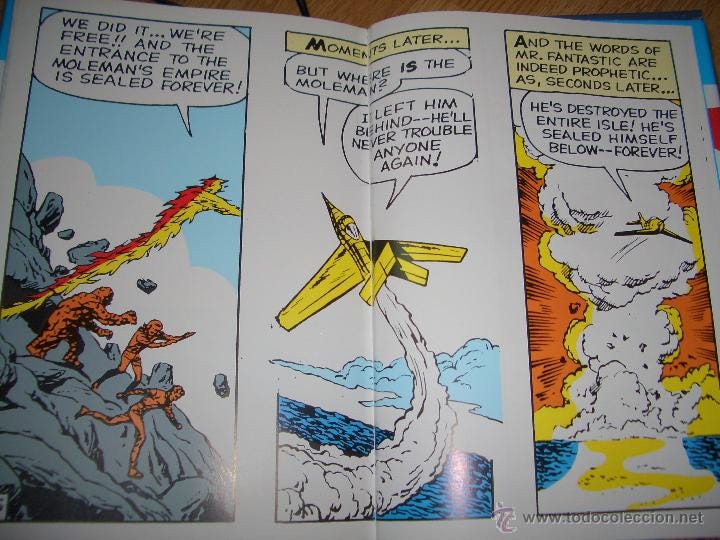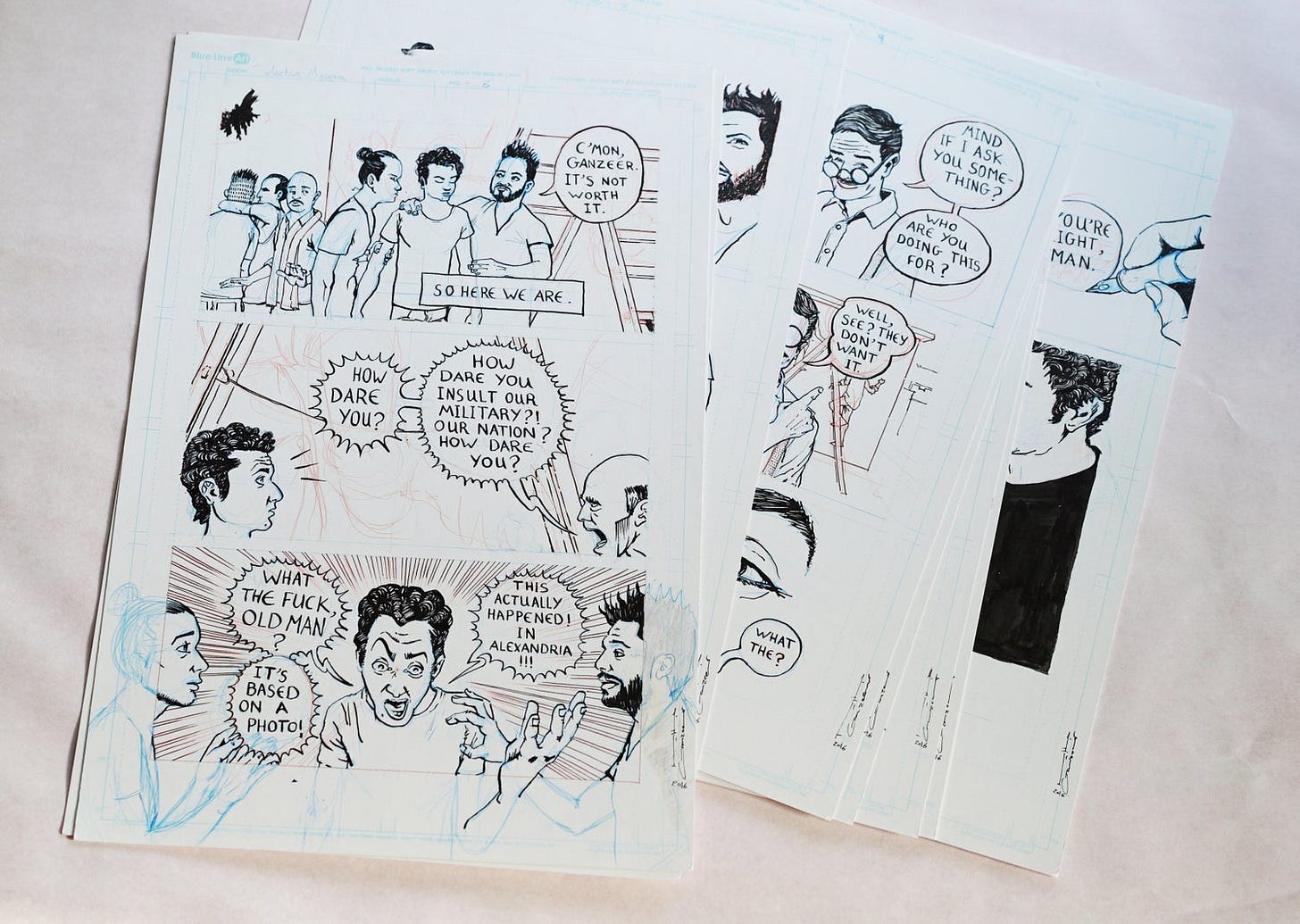1.

Getting faster, working at a rate of about 2 pages a day now. Just pencils though. I follow a pencil day with a day of inking, also 2 pages. So it’s pencil day, ink day, pencil day, ink day, and so on. The idea is to get into a sustained rate of 20 pages a month.
What I used to do before was that if I finished pages earlier in the day, I’d just add more pages, keep working till I couldn’t feel my hand anymore. But that’s what burnt me out on the first couple installments of THE SOLAR GRID. So now, I’m taking a chapter out of Chaykin’s playbook, who limits his activities to the pre-assigned tasks of the day. If I manage to get fast enough to finish 2 pages by, say, noon (I’m an early riser), I’m hoping that should leave me enough time in the day to do other types of art-making, as well as writing, emailing, and all the other stuff.
Whenever I step away from drawing comix, it’s always a struggle to loop back in (same goes for writing and most other skill-based creative endeavors). So the goal is to develop a kind of system that would allow me to do all the things on a daily (or semi-daily) basis.
2.

Been thinking about Will Eisner. In particular, his work on THE SPIRIT. Check out that sequence above where a cigarette is being lit in the dark as a train rolls by in the background, shaking a water jug in the midground. It’s the type of storytelling mechanism comix wouldn’t get to see until WATCHMEN (and to a lesser degree in Frank Miller’s stuff). Eisner pulled that shit off in 1949! What the hell was comix doing in the interim?
Even Kirby who apprenticed under Eisner would never attempt anything close to that. Kirby’s creativity flourished in the characters he was inventing and the exciting storylines he came up with, but if we’re going to be honest the storytelling techniques he employed weren’t the best. His brilliance also lied in the graphic shorthands he would end up developing, his unique markmaking that would come to be known as the Kirby Style.
Eisner was fast too, put out something like 16 pages a week. It is my understanding that he employed assistants and background artists, but still. Worthy of note is that the sequence above is from a 7-page short! It would be superfluous and a waste of “page real estate” to do that sort of thing even in a 20-page comicbook today, but Eisner pulls it off effortlessly in his THE SPIRIT shorts.
He was also one of the earliest independents, effectively creating and publishing his own magazine.
Between reading THE SPIRIT, the first FANTASTIC FOURs, and Ellis/Templesmith’s FELL, I find myself really wanting to do something episodic like that, where I also get to experiment with some storytelling techniques.
THE SOLAR GRID is of course hella experimental, but it’s rather “novelistic” and elaborate. Between now and THE SOLAR GRID’s close, I’ll be taking down notes for future episodic thing. Let’s call it PROJECT WASTELAB.
I’ve talked before about two other project ideas, PROJECT LG and PROJECT TRASHFIRE. Those are longform comix though. Not as long as THE SOLAR GRID, but still novelistic rather than episodic.
PROJECT WASTELAB would be a vehicle for me to do all the projects, starting with the episodic stuff before transitioning into the longform stuff. And not just comix, but also much of the other creative stuff I like to dabble in. Again, a kind of system that would allow me to do all the things. Likely within a format/publishing model outlined in Comix Engine 10.
3.
And now for… the mail:
From: Aisha Azab
Hi hi! If Cairo was a person, how would describe that person?
Weathered old whore with a Cleopatra complex and a heart of gold.
From: Philippe Castelneau
The way you look at Kirby reminded me of a book published in 2005, a re-creation of FF#1, under the supervision of Walter Mosley, a writer of noir novel I particularly like. It's called Maximum FF. Each panel of the first issue of the FF has been enlarged, sometimes full page. Some others pages, there are two or three panels only. The colors have been redone as well, and it's a peculiar book in the end. Not completely satisfying (and way too expensive in my opinion), but it pays a well deserved homage to Kirby's work.I own a worn out copy I bought very cheap, and I don't know if the book is available still. If you have the opportunity some day, check it out, you might find it interesting.
Looked it up online and it does seem like a rather odd book to produce, doesn’t it? Lovely object to behold for Kirby enthusiasts, I’m sure. Looking through what I could find of it online though, y’know what struck me? Any one of those panels in that issue would make a mighty fine largescale painting wouldn’t it?

FANTASTIC FOUR #1 came out in 1961. Had Kirby reproduced only a handful of his comix panels on canvas around the same time the comicbooks were coming out, he could have very easily been heralded as one of the world’s premier pop artists that early on in his career (Not so early, I guess. He was already 44 at the time.). In fact, he would have had a considerable leg up on other would be pop artists given that his paintings would be sourced from his very own comicbooks.
Ah, imagine laying eyes on one those paintings today? 😳 Top tier museum exhibitions, easy.
Sidenote: Painted reproductions of panels from THE SOLAR GRID is something I’ve been considering for a while actually. Granted, the book will in no way ever have the pop-cultural standing of anything like the FANTASTIC FOUR, buuut… given that it is already the subject of academic dissertations as well as exhibitions… I don’t think embarking on such paintings would be entirely frivolous.
4.
Speaking of. Some of my SELECTIVE MYOPIA pages are still available at Garage.Ganzeer for those who like original comix art.

And I’m out. Hope you’re all well. Hit reply if you have any questions or comments you’d like to see in the next newsletter. Hit the heart and/or share button if you think this oughtta be seen by more people.
All the best,
Ganzeer
April 18, 2020
Houston, TX


